How To Make an Effective Study Plan for Your Teacher Certification Exam

 There is no question that taking your teacher certification exam is one of the most stressful and nerve-wracking things you’ll ever have to do. You’ve heard the horror stories from fellow test-takers about how hard the exams are, how even straight A students bomb their teacher certification exams, and you’re determined to not be one of them. Good for you! We’re big believers that attitude and mind-set are critical to success. Know what’s even better? Preparation! How you study matters.
There is no question that taking your teacher certification exam is one of the most stressful and nerve-wracking things you’ll ever have to do. You’ve heard the horror stories from fellow test-takers about how hard the exams are, how even straight A students bomb their teacher certification exams, and you’re determined to not be one of them. Good for you! We’re big believers that attitude and mind-set are critical to success. Know what’s even better? Preparation! How you study matters.
You need to prepare, and to prepare, you need a plan. But, how can you make an effective study plan to keep you on track leading up to your exam? Well, we can help you with that. We’re going to walk you through the steps below, but we want to point out that while you can do this on your own, using study guides such as ours provides the structure many test-takers need. Not only that, but our guides are test-aligned, so you won’t be guessing about which topics you need to study. And lastly, our study guides come with the 240 Guarantee, so you will have the peace of mind you need.
No matter what source you use for your test prep, whether it’s a book, printed study materials or even our 240 Tutoring Study Guides, you need to have an effective study plan. Here are the steps.
1. Determine How Much Time You Have to Prepare
When is your test date? Is it one month away or six months away? If it’s one month away, you will probably need to get started with a more intensive study schedule right away. If it’s more than three months away, you can spread out your studying a bit more. We recommend that you start studying at least two to three months before your exam to avoid last-minute cramming. You will perform better on an exam if you spend 30 minutes studying each day for a month than if you spend 15 hours studying over the two days right before the exam.
Remember teacher certification exams aren’t about memorizing information — they are about understanding concepts and strategies. It’s never a good idea to procrastinate, as the longer you wait, the more anxiety and pressure you are likely to experience. There is no such thing as starting to study too early, unless, of course, you become complacent and stop.
2. Evaluate Your Schedule
You need to think about how often you can realistically study. What commitments do you currently have? How much time do you have available for studying? Can you find time every day or will you need to study every other day? You need to figure out what works for you and your schedule. If your schedule doesn’t leave much room for studying, you might have to rearrange some things. It is most important to create a schedule that you can be consistent with, without large gaps between your study sessions. Keep the learning fresh and moving forward!
3. Consider Your Study Habits
Everyone has a way of studying that works best for them. When designing your study schedule, consider the following — do you study best:
- in the morning or in the evening?
- alone or in a group?
- by reading and taking notes or by listening to audio recordings?
- in a quiet setting or a bustling coffee shop?
- in short 20-min bursts or in longer 1-hour sessions?
Your study plan will be much more effective if it is designed to accommodate your study habits.
4. Make a Schedule
Now that you know how much time you have, and how much time you need, it’s time to create a schedule. To study effectively, we recommend studying in 30-60 minute chunks, as it’s difficult to stay focused for any longer than that. The best schedule is one that you can consistently stick to. It’s a good idea to add your study sessions to your calendar so that you don’t schedule anything else at those times. Or you may even want to download a study planner or calendar app to provide reminders and keep track of your studies. Have reasonable expectations for how much studying is possible given the time you have.
An example study schedule two months before the exam could be 30 minutes reviewing a topic Monday, Wednesday and Friday afternoons, with one longer day for essay practice on the weekend. Just stick with it, and remember that slow and steady wins the race!
5. Learn What the Exam Covers
Once you have set the days and times that you plan to study, it’s time to get to the nitty-gritty of the study plan. First, you’ll have to spend some time learning what the exam covers. You can typically find this information on the exam website. Most exams have a preparation manual, also sometimes called a test blueprint, which outlines the concepts that the exam measures. Some manuals also provide details about what percentage of the exam is made up of each content area, so you can identify the areas that make up a big portion of the exam. We provide all of this information on each of our practice test and prep pages, which you can find under the resources page for your state or exam.
For example, for the Praxis Core Exam, you might find something like:
Mathematics
| Content Categories | Approximate # of Questions | Approximate % of Examination |
| Number and Quantity | 17 | 30% |
| Algebra and Functions | 17 | 30% |
| Geometry | 11 | 20% |
| Statistics and Probability | 11 | 20% |
It is a good idea to consider purchasing a pre-made study guide, like those provided from 240 Tutoring, as this could save you a lot of time by introducing you to the exam and guiding you through your studies. Or you could make your own by researching key topics found on the testing website.
6. Take a Practice Test
Before you begin studying, set aside one day to take a full-length practice exam. You can typically find a free full-length practice test on the testing site, in an exam prep book, or on a test preparation site such as ours. We have free practice tests on our resources pages. Try to re-create real testing conditions by finding a quiet place and timing yourself. Your result on the practice exam will be extremely beneficial in designing your study plan.
7. Review Your Results
Now that you’re more aware of the question types and test rules, score your exam to learn your baseline score. Reviewing your results will give you a better idea of your strengths and weaknesses, and how much time and energy you’ll really need to devote to studying.
As you review the results of your practice exam, it’s helpful to write down all the content categories and keep a tally of which areas you struggled most with on the practice exam.
8. Chunk Content Areas
Using the information from your practice exam and the details you have learned about the composition of the test, you can identify the competencies you are struggling with the most and decide what percentage of your time to devote to reviewing each competency. The most successful test-takers are able to prioritize topics and not spend too much time studying things they already know or things that make up only a small portion of the test.
In the example below, after scoring the mathematics section of the Praxis® Core Exam, the test-taker should note that they will need to spend more time focusing on Number and Quantity and Statistics and Probability than the other content categories.
Just like a textbook breaks down units into chapters and chapters into individual learning points, it’s a good idea to break down your test material and focus on a specific content area or skill each day. Once you figure this out, add these details to your study schedule.
So, once again assuming you are taking the Praxis® Core Exam, and that you’ve determined that your main weakness is mathematics, specifically number and quantity and statistics and probability. You should then set aside more time for studying these topics in your study plan. The first month of a two-month study plan might look something like this:
| WEEK | SUN | MON | TUES | WED | THURS | FRI | SAT |
| 1 | Practice exam | Reading: Key Ideas & Details
(30 min) |
Math: Number & Quantity
(30 min) |
Writing: Text Types & Purposes
(30 min) |
OFF | Math: Number & Quantity
(30 min) |
Essay writing: Review essay types, outlines & past prompts (30 min) |
| 2 | OFF | Reading: Craft, Structure & Language Skills (30 min) |
Math: Statistics(30 min) |
Writing: Language research strategies
(30 min) |
OFF | Math: Probability
(30 min) |
Essay writing: Argumentative (Timed)(30 min) |
| 3 | OFF | Reading: Integration of knowledge & ideas (30 min) |
Math: Geometry
(30 min) |
Writing: Text Types & Purposes
(30 min) |
OFF | Math: Algebra & Functions(30 min) |
Essay writing: Informative/explanatory writing (Timed)
(30 min) |
| 4 | OFF | Reading: Review
(30 min) |
Math: Review(30 min) |
Writing:
Review (30 min) |
OFF | Open for extra practice
(30 min) |
Review general test-taking strategies
(30 min) |
You may prefer to set a specific amount of time to study or number of questions to answer each day, like the schedule below. You can determine what works best for you!
| SUN | MON | TUES | WED | THURS | FRI | SAT |
| Review study guide: Domain 11 hour |
Review study guide: Domain 21 hour |
20 practice questions | Review study guide: Domain 31 hour |
Review study guide: Domain 41 hour |
20 practice questions | OFF |
9. Adjust Your Study Plan, if Necessary
Your study plan is very personal to you. If you are having trouble sticking to it, it’s OK to make a change. After all, designing a study plan is all about figuring out what works best for you.
10. Take a Full-Length Practice Test Near Test Day
It’s a good idea to take more full-length practice tests during your studies, and especially a week or two before your test day to review any areas that you are still struggling with, and remind yourself of the structure and timing of the exam.
A strong study plan should focus most on your areas of weakness and the areas that are most prominent on the exam. However, there is no one-size-fits-all study plan that works for everyone. The best study plan is one that is realistic and works for you.
Need help studying for your teacher certification exam? We helped 49,649 educators pass their exams last year — and we are ready to help you! Start studying today.

